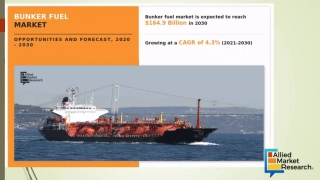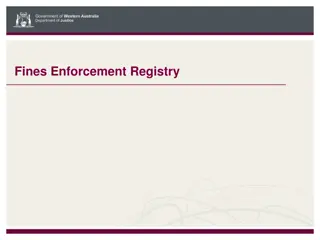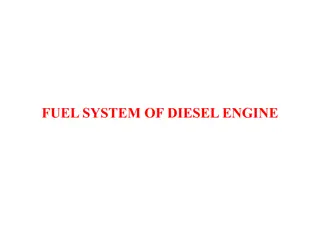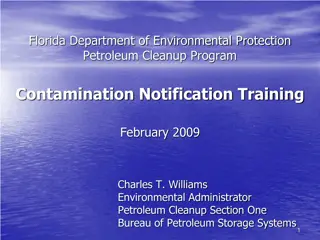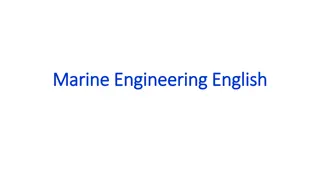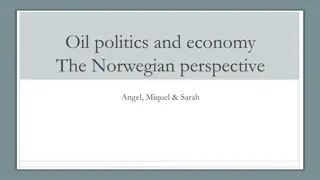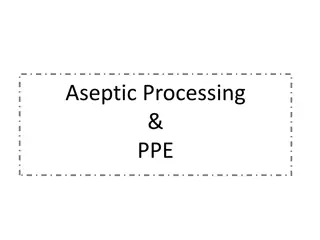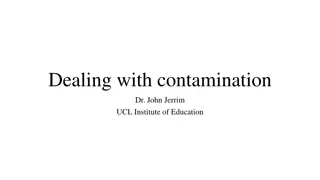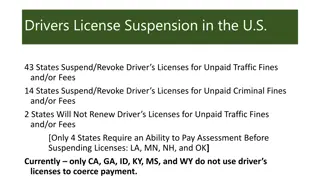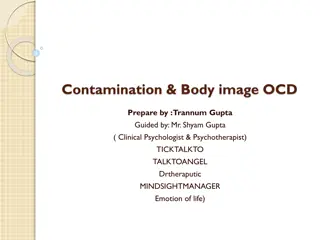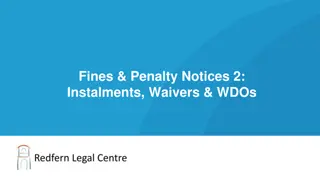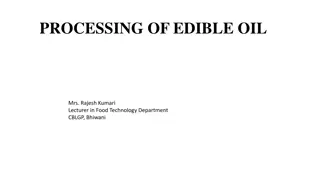Understanding Cat Fines in Marine Fuel Oil Contamination
Cat fines are abrasive particles found in residual fuel oil, which can cause significant damage to marine engines. They result from the distillation process and are hard and abrasive substances that can lead to costly engine repairs. As more fuel is refined this way and with the push for low-sulfur fuels, the issue of cat fines is becoming more prevalent in the marine industry.
Download Presentation

Please find below an Image/Link to download the presentation.
The content on the website is provided AS IS for your information and personal use only. It may not be sold, licensed, or shared on other websites without obtaining consent from the author. Download presentation by click this link. If you encounter any issues during the download, it is possible that the publisher has removed the file from their server.
E N D
Presentation Transcript
INTERNATIONAL MARINE CLAIMS CONFERENCE - 2015 DAMAGES DUE TO CAT FINES Mark McGurran Manager, Marine Engineering Services Regional Manager, Hull & Machinery
What are Cat Fines? Not a cat that wants to fine you and eat your dollars $$$ But the end result can still be very expensive
Cat Fines are abrasive particles, or fines, that are found in residual fuel oil. By residual fuel oil, we mean heavy fuel oil (HFO), including intermediate fuel (IFO). Heavy oil is the residual oil left over after the lighter distillate fuels have been distilled and removed from the crude stock oil. Heavy oil is consumed in the main engines of the majority of the worlds internationally traded vessels, and in most cases in the auxiliary engines also. There are various methods of distillation used to remove these distillates and arrive at the residual oil.
The traditional factional distillation method of separating crude oil into it s distillate and residual oil parts uses heat to bring the stock oil to the different boiling point temperatures of the various distillates. http://www.edplace.com/userfiles/image/fractional%20distillation%202.jpg
Another kind of distillation is Catalytic Cracking. The stock oil is passed through a rector containing chemicals (catalysts) in the form of alumina and silica in a fine powder under high pressures and temperatures. http://www.eia.gov/todayinenergy/images/2012.12.11/FCCdiagram.png
The silica and alumina catalyst powder should remain on the reactor side, but inevitably carryover into the distillate column occurs resulting in the residual oil and the slurry containing the abrasive substance known as Cat Fines. Cat fines are therefore basically aluminium and silicone oxides in small or fine particle form. They are very, very hard and abrasive. So hard in fact that when compared on the Mohs scale, they can be almost as hard as diamonds
Question: How many of you have been involved in a Cat Fine claim recently? A Yes A No
The problem is getting worse. More fuel is being refined this way, and to compound the problem there is now a drive for low sulphur fuels. One of the common methods of producing low sulphur fuels is to mix in the slurry from the catalytic cracking process thus bringing down the total sulphur content. So not only do we have Cat Fines in the residual oil to begin with but we are adding slurry with more Cat Fines into the mix.
It doesnt end there. In some parts of the world used lube oils (ULO) is mixed into the residual oil to achieve different grades. The addition of these ULO, due to their inherent additives, leads to an emulsifying effect resulting in the dirt, water and Cat Fines being suspended in the fuel oil. This of course makes it much harder to remove these impurities before the fuel is consumed.
What damage is caused by Cat Fines? If Cat Fines find their way into an engine they will usually get embedded in the softer metal surfaces of the of the cylinder liners and piston rings. They will also negatively impact the operation of the fuel pumps and injectors whose fine tolerances and polished running surfaces are intolerant to such hard, abrasive elements. If fuel that contains high levels of Cat fines is consumed in the engine, levels of wear that would usually take place over years can occur in a matter of days or weeks.
Piston crown with broken and missing rings due to Cat Fines
Cat Fines are particularly damaging to cylinder liners as their surfaces are not polished and smooth, but are honed to give an open graphite surface texture which promotes the lube oil to adhere to the surface minimizing metal to metal contact. Cat Fines damage impact both four and two stroke engines, but tends to have a more devastating result on two stroke engines as the four stroke method of splash cylinder lubrication is better at washing the abrasive particles away.
Cat Fines damage can lead to the need to replace all pistons, piston rings, cylinder liners, cylinder heads & valves, turbochargers, fuel pumps basically any engine component that came into contact with the fuel. If an engine is allowed to continue to operate with excessively worn components due to Cat Fine damage the possibility exists for even greater damage to other parts of the engine or propulsion / generation systems due excessive vibration and stresses.
Question: Is this wear considered ordinary wear & tear? A Yes A No
Levels of Cat Fines ISO specification outline bunker fuel quality on a variety of parameters. The latest specifications, ISO 8217 : 2012 gives the maximum Cat Fines level as 60mg per kg of fuel. As a guide, the industry standard for many engine builders recommend a maximum limit of 7 to 15mg per kg. There is therefore obviously a gap here. Fuel can pass the ISO bunker specification but can still be potentially very damaging to an engine.
Detecting Cat Fines Once an engine is suspected of having been damaged by Cat Fines, the piston rings and replicas of the cylinder liner walls can be examined under magnification to look for evidence of Cat Fines. http://www.motorship.com/__data/assets/image/0004/776146/Chrismarine2.jpg A magnification of a cylinder liner wall showing a 25 micron Cat Fines particle embedded in the wall
http://officerofthewatch.files.wordpress.com/2013/05/2013-05-24-engine-worn-out-by-catalytic-fines-figure-3.jpghttp://officerofthewatch.files.wordpress.com/2013/05/2013-05-24-engine-worn-out-by-catalytic-fines-figure-3.jpg A magnification of cylinder liner walls showing typical accelerated wear marks due to Cat Fines and a cluster of Cat Fine particles embedded in the surface.
The cost of Cat Fines Costs relating to Cat Fines damages can be significant. Although there isn t really an averagevessel if we look at a middle of the road vessel fitted with a single 30,000bhp slow speed diesel requiring the following repairs due to Cat Fines: Replacement pistons, piston rings, cylinder liners, fuel pumps and having cylinders heads and the turbo charger overhauled. We are looking at a repair costs of somewhere in the region of US$700,000 to US$1,000,000 before any auxiliary engine damage repairs.
Cause and Prevention Obviously Cat Fines can t be a cause if there are no Cat Fines in the fuel in the first place. If the fuel fails the ISO specification then the bunker supplier is at fault so there will not likely be a claim. Therefore the main reason that the presence of Cat Fines in fuels results in claims is the failure to properly process the fuel on board to bring the Cat Fines levels down from that which can pass ISO to that which can safely be consumed in the engine.
This is achieved by proper handling, filtration and purification of the fuel on board. For this to be successful there needs to be the correct procedures in place and both the correct equipment and correct levels of crew competency on board. Bunkers must be tested and results received and analysed BEFORE they are consumed on board. This requires effective procedures. bunker management Filtration and purification systems must be fitted and properly maintained and operated. This can be difficult given that only modern centrifuges are truly capable of handling modern heavy fuels with specific gravities approaching 1.01.
Question: If a vessel is not fitted with modern centrifuges and proper filtration, can a successful crew negligence claim be made that the crew did not reduce the Cat Fines levels as they were supposed to? A Yes A No
Once the fuel is properly purified it can be sent to the service tank. From there it needs to be handled and filtered correctly before being admitted to the engine. A typical fuel system is shown on the next slide. It shows that there are at least three sets of filters in the system. This may seem like a lot but they can only be effective if they are suitable for the job and are maintained and operated correctly. Many engine manufactures also indicate that a maximum Cat Fines particle size of around 15 mircons is acceptable but they don t always fit filters below 20 microns!
Question: Should the ISO specifications need to be adjusted to a level that the engines can cope with regardless of the on board treatment? A Yes A No
Mark A. McGurran London Offshore Consultants Singapore Pte Ltd +65 9634 4825 m.mcgurran@loc-group.com Thank You!




